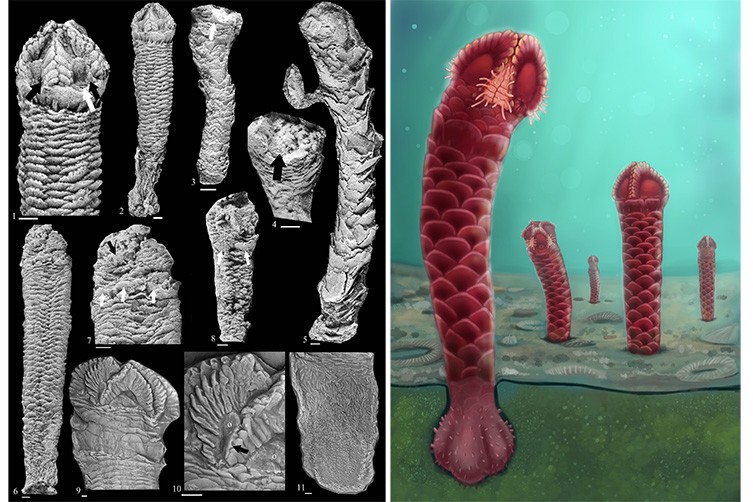@ WFS,World Fossil Society, Riffin T Sajeev,Russel T Sajeev
A species of wormlike marine invertebrate has been uncovered.
The animals are fossil echinoderms from the Silurian Period, making them about 435 million years old. Now extinct, they are distant relatives of starfish and sea cucumbers.
They were found after researchers discovered a group of well-preserved fossils from Anticosti Island in Quebec, Canada. An investigation revealed that the fossils are a newly described species, now named Rhenopyrgus viviani.
Discoveries like this allow us to understand more about how life on Earth has evolved. The Silurian Period was about 200 million years before the first dinosaurs, and it saw the first plants and animals emerge onto land.
Researchers still have a lot to learn about the organisms that flourished during this period of Earth’s history.

Photographs of the specimens in the study (left) and a reconstruction of how the extinct animals could have looked (right)
Museum curator Dr Tim Ewin, who led the research team for this study, says, ‘A big part of understanding early life is simply knowing what that life looked like and how it behaved. Being able to accurately reconstruct an animal gives us valuable insights into how it lived and in cases, such as this, they can prove to be quite unique in appearance and have surprising behaviour.
‘By expanding our knowledge of how animals in the past lived and evolved we can better understand why they became extinct and so protect the biodiversity of our planet today.’
It was previously thought that these animals lived in burrows and were able to bury themselves in sediment and hide away.
But Dr Ewin thinks they were actually bottom-dwelling ‘mud-stickers’ that stood erect.
The animals were supported by the insertion of a bulbous, sac-like structure at the base of the stem into a muddy sea floor. They were only able contract a small part of the top of the stem, to protect important openings such as the anus.
Dr Ewin continues, ‘Rather than living in mud burrows, we now believe these creatures protruded from the sea floor, displaying a degree of flexibility.
‘This allowed them to place their mouth higher up into the water column to feed. It is remarkable how new fossil evidence can alter our perceptions of ancient life.’
The new paper also identified greater diversity in the construction of the mouth of rhenopyrgids (a type of edrioasteroid) than previously thought.
This diversity of form has also been seen in other stalked edrioasteroids suggesting convergent evolution of these adaptations.
Source: Natural History Museum.UK
@ WFS,World Fossil Society, Riffin T Sajeev,Russel T Sajeev



 September 21st, 2019
September 21st, 2019  Riffin
Riffin  Posted in
Posted in  Tags:
Tags: 